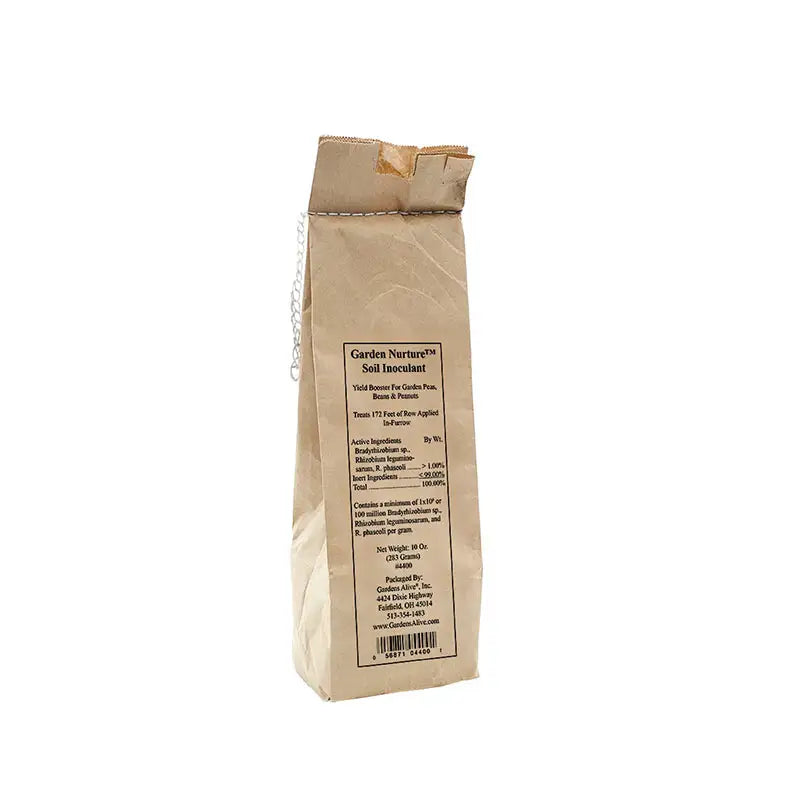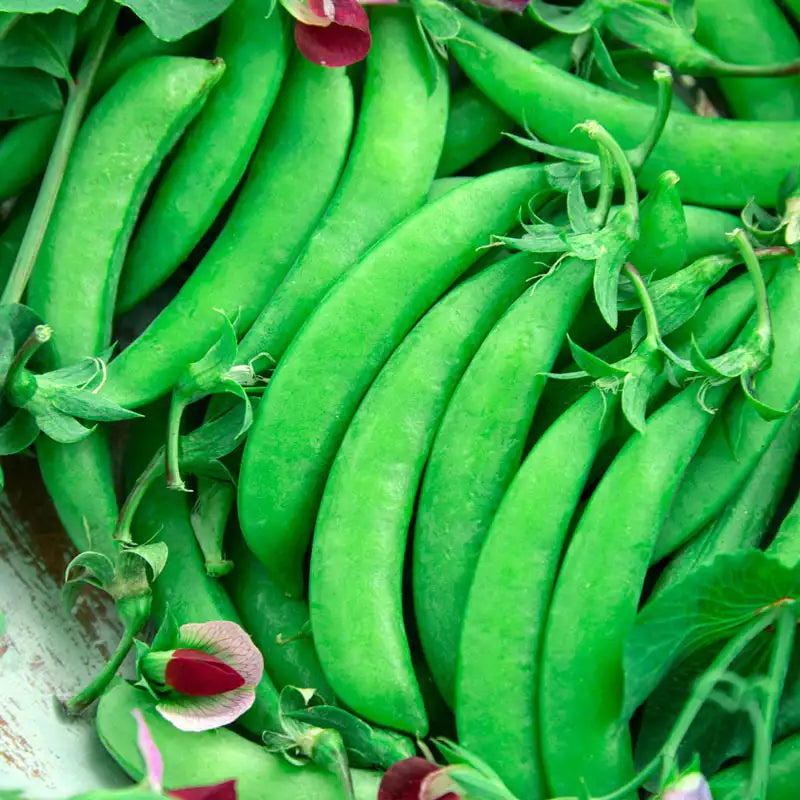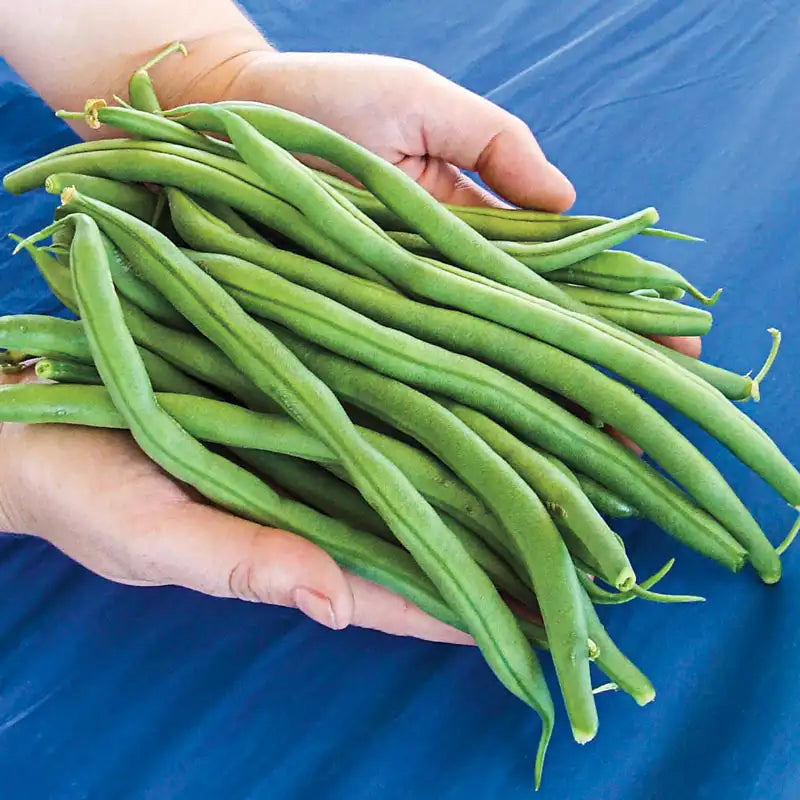Peas & Beans; to Start indoors? Or Not to Start? That IS This Week's Question!
Q. Jeanine writes: "We live in Washington state. When would be the best time to start planting snap pea and green bean seeds indoors to transplant outside later? And what is the best method to start the seeds?"
A: To quote the all-knowing Internet, "Washington growing zones are wide-ranging and can be anywhere from 4a to 9a, although much of the state falls into the range of 6a (on the eastern half of the state) to 9a (on the western half).
USDA Zone 6a is pretty common across the country; my place in PA is either 6a or 6b (which is a little warmer than 6a, but not quite a Zone 7). Higher Zone numbers indicate warmer wintertime lows, while low numbers mean it gets darn cold in winter. Darn cold. Luckily I don't need to know Jeanine's exact location, as the point with these crops is, as they say, moot. (I don't know why they say it; they just do.)
Both peas and beans are 'direct-sown' crops; meaning that you plant the seeds right in the ground as opposed to starting them inside, like tomatoes and peppers. They are also both legumes, which means that if their roots come into contact with the right types of soil bacteria, they gain the ability to feed themselves with Nitrogen from the air, which is wicked cool. You can buy the correct bacteria (called a pea and bean 'inoculant') in powdered form at your friendly neighborhood garden center. Or HERE (if GA or Gurney's sells it).
But those two things are all they have in common, because peas are a cool-weather Springtime crop and beans are a warm-weather crop of the Summer, like them tomatoes and peppers we just mentioned.
All types of peas (snap peas, snow peas and English shelling peas) will naturally wither and die about the same time life gets good for green beans, which makes the timing of the peas extremely important. Virtually all varieties of pea have a 'days to maturity' rating of between 50 to 70 days, which in most regions means you'll be giving them all of April and May to grow, with you getting all of June to pick and enjoy. (That's why they're sometimes called 'June peas'; in most places they're pushin' up the daisies by the 4th of July.)
Here in the East, many gardeners believe that planting your peas on St. Patrick's Day is good luck; which it is not if there's still snow and/or frozen soil in your garden. But the timing makes sense as St. Patrick's Day falls on March 17th this year, and if you plant around that date in soil that is not frozen, you might start picking your first peas in late May. But you only get one real shot at this crop each year (Fall planting is theoretically possible, but my math skills are such that I no longer try it); and so we will explain how you can cheat your way into pea heaven. (As we always like to remind our younger listeners, "remember kids; cheaters always win.") Unless you get caught.
Anyway, here's the deal. Select the bed in which you will plant your pea seeds and remove any mulch covering the soil to allow it to warm up faster. It would also not be wrong to cover that bed with a one or two mil thick sheet of clear plastic to further the path to warm soil. Then, while we will not start our pea seeds indoors the tomato and pepper way, we will pre-sprout them. About a week after you start warming the soil, take your pea seeds, which are big and easy to handle, and put them into Zip Loc bags with enough moist paper towels to cover all the seeds. Do not Zip the bags shut; just fold them over and place them out in the open in a warm room. Check the seeds daily. If there's no sign of moisture on the bag(s) add a little water, or even better, use a mister. Or a Ms.
After five to seven days, you should see little squiggles coming out of some of the seeds. Leave the bag open now to prevent mold, but keep misting gently. Then, when the planets are all aligned (most of the seeds have nice sized squiggles and the soil outside is workable (as in not frozen) plant your pre-sprouted seeds. If you have the inoculant at hand, dust it into the planting holes or rows right with the seeds. Although the seeds would probably have rotted in the cold wet soil of Spring, the sprouted seeds (and the plants to come) don't mind cool weather; in fact, they require it.
You're not done yet. Some varieties will have the word "bush" associated with their name; this means that the vines will top out at around two feet tall and require minimal support. If they don't say 'bush' they will need to be trellised or they'll collapse into an ungodly mess. Check the packet, seed catalog or website description for the final height of your specific variety; and respect it.
And then you wait. When the first pea pods appear, pick them correctly. You eat snow peas and snap peas 'pod and all', so: Pick snow peas at any size; if you can see it, you can eat it. Pick snap peas a little larger, but don't let the seeds inside get too big. The smallest pods taste the best; and not allowing the seeds to get too big inside the pods means the plants will keep producing prodigiously.
"English" or 'shelling peas' are a little different. With this type you eat the peas and not the pod, so when the pods start to swell, sample one daily. Zip off the handy string running down the side of the pod and savor the peas inside. When they get to be the size of the ones the Jolly Green Giant puts in those famous "Le Sueur" cans, begin harvesting in earnest for one of Springtime's tastiest treats. (Steamed peas served with garlic butter!) If you want dried peas for winter soups and such, let the final pods sit on the vine until they turn completely brown and then harvest.
When the vines start to shrivel and die, pick what's left and clear that bed for a new crop; like green (or any other kind of) beans, which need no pre-sprouting because the soil is now nice and warm. They will be designated as 'bush' (well behaved) or 'pole' (requiring a sturdy trellis); again, respect the final height of your specific variety. Beans will persist until frost; as should you.
Note: I could be wrong, but I don't think I've ever seen a pea packet that said 'pole'. Bush, yes, but not pole. So if it doesn't say 'bush', look for final height info...
A: To quote the all-knowing Internet, "Washington growing zones are wide-ranging and can be anywhere from 4a to 9a, although much of the state falls into the range of 6a (on the eastern half of the state) to 9a (on the western half).
USDA Zone 6a is pretty common across the country; my place in PA is either 6a or 6b (which is a little warmer than 6a, but not quite a Zone 7). Higher Zone numbers indicate warmer wintertime lows, while low numbers mean it gets darn cold in winter. Darn cold. Luckily I don't need to know Jeanine's exact location, as the point with these crops is, as they say, moot. (I don't know why they say it; they just do.)
Both peas and beans are 'direct-sown' crops; meaning that you plant the seeds right in the ground as opposed to starting them inside, like tomatoes and peppers. They are also both legumes, which means that if their roots come into contact with the right types of soil bacteria, they gain the ability to feed themselves with Nitrogen from the air, which is wicked cool. You can buy the correct bacteria (called a pea and bean 'inoculant') in powdered form at your friendly neighborhood garden center. Or HERE (if GA or Gurney's sells it).
But those two things are all they have in common, because peas are a cool-weather Springtime crop and beans are a warm-weather crop of the Summer, like them tomatoes and peppers we just mentioned.
All types of peas (snap peas, snow peas and English shelling peas) will naturally wither and die about the same time life gets good for green beans, which makes the timing of the peas extremely important. Virtually all varieties of pea have a 'days to maturity' rating of between 50 to 70 days, which in most regions means you'll be giving them all of April and May to grow, with you getting all of June to pick and enjoy. (That's why they're sometimes called 'June peas'; in most places they're pushin' up the daisies by the 4th of July.)
Here in the East, many gardeners believe that planting your peas on St. Patrick's Day is good luck; which it is not if there's still snow and/or frozen soil in your garden. But the timing makes sense as St. Patrick's Day falls on March 17th this year, and if you plant around that date in soil that is not frozen, you might start picking your first peas in late May. But you only get one real shot at this crop each year (Fall planting is theoretically possible, but my math skills are such that I no longer try it); and so we will explain how you can cheat your way into pea heaven. (As we always like to remind our younger listeners, "remember kids; cheaters always win.") Unless you get caught.
Anyway, here's the deal. Select the bed in which you will plant your pea seeds and remove any mulch covering the soil to allow it to warm up faster. It would also not be wrong to cover that bed with a one or two mil thick sheet of clear plastic to further the path to warm soil. Then, while we will not start our pea seeds indoors the tomato and pepper way, we will pre-sprout them. About a week after you start warming the soil, take your pea seeds, which are big and easy to handle, and put them into Zip Loc bags with enough moist paper towels to cover all the seeds. Do not Zip the bags shut; just fold them over and place them out in the open in a warm room. Check the seeds daily. If there's no sign of moisture on the bag(s) add a little water, or even better, use a mister. Or a Ms.
After five to seven days, you should see little squiggles coming out of some of the seeds. Leave the bag open now to prevent mold, but keep misting gently. Then, when the planets are all aligned (most of the seeds have nice sized squiggles and the soil outside is workable (as in not frozen) plant your pre-sprouted seeds. If you have the inoculant at hand, dust it into the planting holes or rows right with the seeds. Although the seeds would probably have rotted in the cold wet soil of Spring, the sprouted seeds (and the plants to come) don't mind cool weather; in fact, they require it.
You're not done yet. Some varieties will have the word "bush" associated with their name; this means that the vines will top out at around two feet tall and require minimal support. If they don't say 'bush' they will need to be trellised or they'll collapse into an ungodly mess. Check the packet, seed catalog or website description for the final height of your specific variety; and respect it.
And then you wait. When the first pea pods appear, pick them correctly. You eat snow peas and snap peas 'pod and all', so: Pick snow peas at any size; if you can see it, you can eat it. Pick snap peas a little larger, but don't let the seeds inside get too big. The smallest pods taste the best; and not allowing the seeds to get too big inside the pods means the plants will keep producing prodigiously.
"English" or 'shelling peas' are a little different. With this type you eat the peas and not the pod, so when the pods start to swell, sample one daily. Zip off the handy string running down the side of the pod and savor the peas inside. When they get to be the size of the ones the Jolly Green Giant puts in those famous "Le Sueur" cans, begin harvesting in earnest for one of Springtime's tastiest treats. (Steamed peas served with garlic butter!) If you want dried peas for winter soups and such, let the final pods sit on the vine until they turn completely brown and then harvest.
When the vines start to shrivel and die, pick what's left and clear that bed for a new crop; like green (or any other kind of) beans, which need no pre-sprouting because the soil is now nice and warm. They will be designated as 'bush' (well behaved) or 'pole' (requiring a sturdy trellis); again, respect the final height of your specific variety. Beans will persist until frost; as should you.
Note: I could be wrong, but I don't think I've ever seen a pea packet that said 'pole'. Bush, yes, but not pole. So if it doesn't say 'bush', look for final height info...




